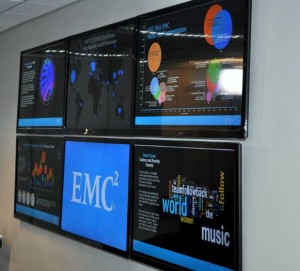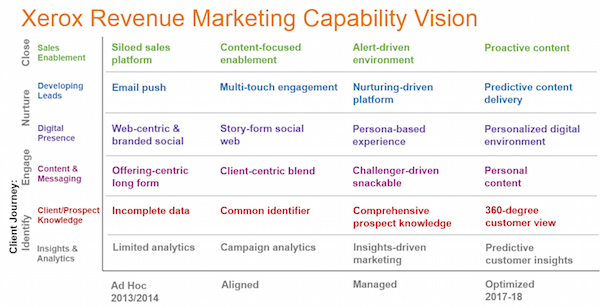
Jonathan Martin, the CMO of EMC, was a computer scientist by training. On nights and weekends, he was a musician in a band. That correlation between software engineering and musical talent is actually not uncommon — and illustrates why technologists are often artists of a digital medium, writing code to express ideas and affect an audience.
From that start, Jonathan moved into pre-sales and product marketing at VERITAS (acquired by Symantec in 2004), became the CMO of an identity management start-up, PortWise, the VP of product marketing at Salesforce, and the CMO at HP Software. In 2011, he joined EMC, where he is now the CMO.
In a week’s time, he will join me at the MarTech conference with Rishi Dave, the CMO of Dun & Bradstreet, for a special fireside chat on How MarTech Makes the CMO the Champion of Company-Wide Digital Transformation. In advance of the conference, Jonathan and I had a chance to chat about some of his experience and perspective on the way marketing is changing — and the role that marketing technology has in that transformation.
EMC does $25 billion a year in revenue globally. A third of the world’s business information sits on the equipment it sells. They’ve clearly got strong products and a strong sales organization. But when Jonathan joined the company, the challenge was to make their marketing organization more “contemporary.” I took that as a euphemism, like “modern marketing,” for reengineering EMC’s marketing department with the new capabilities and cadence that the digital world demands.
“Three years ago, we were talking about big data,” he told me, as the company was selling big data solutions to customers. The realization in marketing: “We need to use it ourselves.”

They tackled this by creating a “marketing sciences lab,” a team of data scientists with access to a massive marketing and sales data lake: customer data, financial data, service data, support data, web metrics, raw feeds from social media, and so on. Today, those data scientists are fishing in that data lake. They’re managed and rewarded by the concrete recommendations that they make for marketing programs — and the actual adoption rate of those recommendations. “Analytics is now at the core of everything we do,” Jonathan said.
This common data lake was built by IT and is shared — and funded — by all functional areas, including marketing and sales. Each has their own data scientists mining it for insights. But IT also provides a small pool of additional data scientists who are available as “surge capacity” for either department to leverage. Given the intense competition for data scientists in the market these days, this gives them the ability to quickly pursue new data-driven opportunities, without the lag time of recruiting new talent from scratch.
What’s the real advantage to marketing of this giant data lake?
What our marketing tech is trying to do is to understand the context of somebody in their [buyer’s] journey.
“The buyer’s journey today is not linear, but more like Chutes and Ladders,” Jonathan said. “What our marketing tech is trying to do is to understand the context of somebody in their journey, understand their intent predictively, and understand those two things in real-time as much as possible.”
In addition to this marketing sciences lab, Jonathan has a separate marketing technology group, managed in collaboration with IT. This team is responsible for finding and evaluating new technologies that will help the CMO achieve his business objectives. They also own the playbook for rolling out those technologies across the rest of the marketing team.
We had one of everything — sometimes five of everything, such as content management systems.
More recently, they’ve led the effort to consolidate marketing technology infrastructure. “We had years and years of technology history scattered across the marketing department,” Jonathan remarked. “We had one of everything — sometimes five of everything, such as content management systems. So 9 months ago, we laid out a new agenda to consolidate these technologies to a small number of high-impact elements.” They’ve based a lot of that infrastructure around a single marketing platform, which they’ve extended in strategic spots with more specialized products, such as for social listening.
The paragon of IT and marketing collaboration that they have today, however, wasn’t achieved without some struggles. They had a tense relationship with IT for a while, which Jonathan attributed to the different time scales in which projects were typically implemented — marketing wants something this quarter, sales wants it yesterday, but IT historically mapped out initiatives in months and years — and the collision of teams speaking two very different languages.
Marketing’s perspective is that we are now dependent on technology to deliver our mission.
But they tackled those challenges head on. A new CIO, Vic Bhagat, came in three years ago, and they created the marketing technology group that has one foot in IT and one in marketing. “Marketing’s perspective is that we are now dependent on technology to deliver our mission,” Jonathan said. “Marketers have become very technology savvy.”

Indeed, EMC runs a program to make sure that all the marketers in their organization — hundreds of people around the globe — continually renew accreditations for new technologies and techniques every year. They also fund an open innovation program, called Launch Pad, that encourages employees to develop new ideas in an entrepreneurial fashion. Jonathan likened it to a Dragons’ Den — or Shark Tank — experience inside the company that generates a lot of excitement, but also effectively gives innovators the money and support to prove their ideas.
We’re heavy users of agile marketing, and our marketing technology playbook is one of those agile processes.
EMC has also been one of the pioneers of agile marketing. (For example, read this fascinating interview with David Quinn and Amy Callahan from EMC on agile marketing from two years ago.) “Agile processes have become our default for any cross-functional initiative,” said Jonathan. “We’re heavy users of agile marketing, and our marketing technology playbook is one of those agile processes.”
When I asked Jonathan what he felt was the biggest shift in marketing’s worldview — in the profession overall, not just at EMC — he replied, “Growth.”
“Marketing’s agenda is the growth agenda for the company,” he said. “Growth in three dimensions. Growth in the top line of the business, the ability to drive revenue. Growth in the magnetism of the brand you build — Apple is the epitome of the magnetic brand — which leads to growth in your margins. And that can be challenging for B2B companies. Ultimately though, growth in shareholder value.”
Marketing’s agenda is the growth agenda for the company. Ultimately, growth in shareholder value.
For marketers rising in board-level influence, that last one is the real key to success.
Want to hear Jonathan share more of his digital transformation experience in person? Join us at MarTech next week in San Francisco! Nearly 1,000 digital marketing and marketing technology leaders will be gathered for two days of learning, inspiration, and networking.



I wish I was there, but i’m in Florida now, Scott. so I cannot be there. Sorry.
Jeffrey L. Ogden, President
http://findnewcustomers.com
Jonathan’s observation that “What our marketing tech is trying to do is to understand the context of somebody in their journey, understand their intent predictively, and understand those two things in real-time as much as possible” hits on a key point. Marketers need all three – actions (the components of the dialogue from both customer and brand), decisions (machine-learning intelligence to select the optimal response), and customer profiles (the containers for all the data about that individual – to successfully engage with today’s buyers. It’s when the strategies and technologies that support each of these pillars are out of sync and disparate that marketers fail to interact effectively throughout the “chutes and ladders” game that is the customer journey.
There is hope for us all.